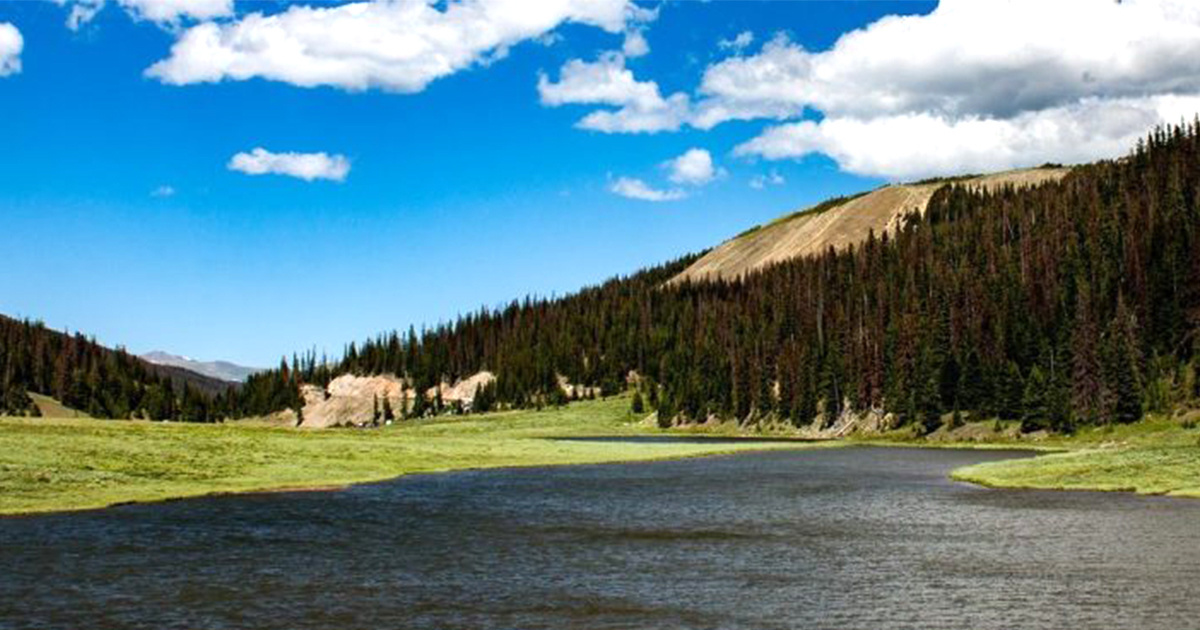
‘It’s Raining Plastic’: Researchers Find Microscopic Fibers in Colorado Rain Samples

A lake in Rocky Mountain National Park. Brett Walton / Circle of Blue
By Brett Walton
When Greg Wetherbee sat in front of the microscope recently, he was looking for fragments of metals or coal, particles that might indicate the source of airborne nitrogen pollution in Rocky Mountain National Park. What caught his eye, though, were the plastics.
The U.S. Geological Survey researcher had collected rain samples from eight sites along Colorado’s Front Range. The sites are part of a national network for monitoring changes in the chemical composition of rain. Six of the sites are in the urban Boulder-to-Denver corridor. The other two are located in the mountains at higher elevation.
The monitoring network was designed to track nitrogen trends, and Wetherbee, a chemist, wanted to trace the path of airborne nitrogen that is deposited in the national park. The presence of metals or organic materials like coal particles could point to rural or urban sources of nitrogen.
He filtered the samples and then, in an inspired moment, placed the filters under a microscope, to look more closely at what else had accumulated. It was much more than he initially thought.
“It was a serendipitous result,” Wetherbee told Circle of Blue. “An opportune observation and finding.”
In 90 percent of the samples Wetherbee found a rainbow wheel of plastics, mostly fibers and mostly colored blue. Those could have been shed like crumbs from synthetic clothing. But he also found other shapes, like beads and shards. The plastics were tiny, needing magnification of 20 to 40 times to be visible and they were not dense enough to be weighed. More fibers were found in urban sites, but plastics were also spotted in samples from a site at elevation 10,300 feet in Rocky Mountain National Park.
The findings are detailed in a report published online on May 14.
Where did the plastic fibers come from? Are they locally produced, or carried from distant states or countries? How do they affect fish and other aquatic life after the plastics precipitate out in rain? And just how much plastic is aloft? Austin Baldwin, a study co-author, would like to know.
“There are more questions than answers right now,” Baldwin, a USGS hydrologist who studies microplastics, told Circle of Blue.
Plastic pollution is ubiquitous, an unfortunate residue of contemporary consumer culture. Bottles, bags and containers litter beaches and clog streams. Seabirds and whales eat the debris, their stomachs coming to resemble a garbage bin.
These are the most visible signs of an even deeper problem. The consequences of microplastics, those comparable to grains of salt or human hairs, are less well understood. Baldwin said there are even fewer studies to date that have examined microplastics in rain. He mentioned two studies from Paris and one from the Pyrenees. “It’s kind of exciting,” in the sense of scientific discovery, he said.
The atmosphere is a powerful and tireless recirculator — of pollution as well as water. Dust carried by wind and rain from America’s southern deserts falls on the Rocky Mountains and causes snowpack to melt more quickly. Mercury emissions from thermal power plants as distant as China have been detected in the remote alpine lakes of Olympic National Park and Mount Rainier National Park, where the toxic chemical is consumed by fish. Even PFAS compounds, the contaminants du jour, hitch an aerial ride. New Hampshire regulators traced groundwater contamination near a Saint-Gobain manufacturing facility to the site’s blower stacks, which had lofted the chemicals into the air before they precipitated onto land.
Baldwin outlined several theories for the source of microplastics in Colorado. The fibers suggest the residue from synthetic clothing. Residential clothes dryers could be venting a waste stream into the air, he said. Or laundry water could be a source. Fibers sent to a wastewater treatment plant could end up in the sludge that is then spread on farm fields for fertilizer. As the sludge dries, the fibers could be lifted into the air. Another possible source could be the slow degradation of car tires.
The next step is to estimate the mass of microplastics in rain and whether the phenomenon is evident in other regions. Wetherbee said that an evaluation of snow-season deposition of microplastics across the U.S. Rockies, from Montana to New Mexico, is already in progress.
Though individual microplastics have their own shape, size and chemistry, Baldwin did not think that the Colorado sites are particularly unique. The fibers could have been carried for a significant distance.
“We’re seeing plastics virtually everywhere we look,” he said.
Reposted with permission from our media associate Circle of Blue.
- Scallops Absorb Billions of Microplastics in Just 6 Hours - EcoWatch
- 'Plastic Rain' Is Pouring Down in National Parks - EcoWatch

 233k
233k  41k
41k  Subscribe
Subscribe 